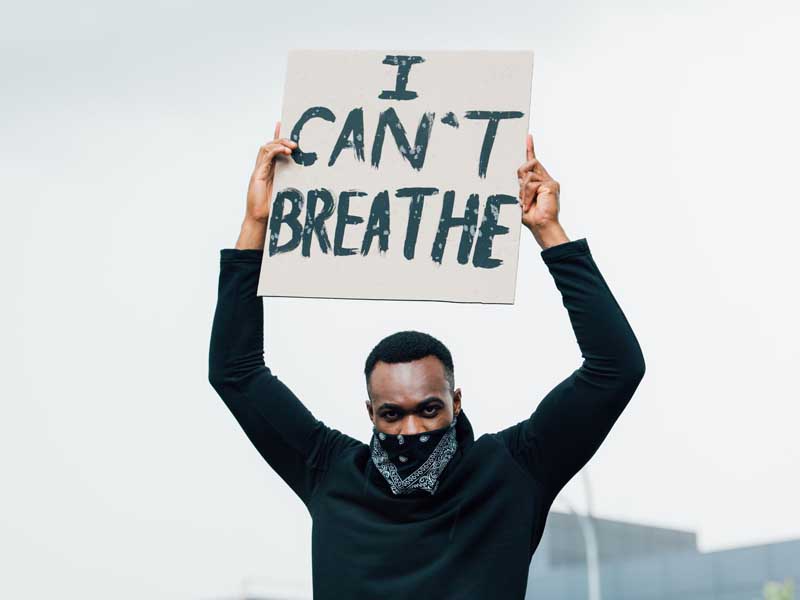Why We Fight for Patients of Color
"I can't breathe" was the complaint. This was her fourth admission for COVID-19. She'd been swab negative, antibody positive for some time, but that didn't stop her 60-80% throat scarring from significantly narrowing her airway, a feeling of choking compounded by her pregnancy.

"I can't breathe," George Floyd said as he died in police custody, under a policeman's knee, where he lied for eight minutes and 46 seconds. He was choking from a different disease -- not COVID-19, but structural racism that has been an integral part of our country from its very roots.
"I can't breathe," my patient said again. The nurses paged me, and I went to see her. As she choked and had stridorous breathing, I became nauseated just listening to her. My arms became tingly. I realized that I -- her physician on the day she was admitted, the day she was intubated, during her third readmission and now her fourth -- was perhaps going to pass out. I sat down next to her and helped her calm her breath, all the while being dizzy myself. I was shocked by my own physical distress in response to her difficulty breathing.
"I can't breathe," George Floyd said in that street as bystanders filmed what was happening. He called for his mother, dead two years already. And again, as I watched online, I was nauseated, I had chills.
Both my patient and George Floyd are people of color. Both are victims of structural racism, COVID-19 and excessive police force, all of which are found disproportionately in our Black communities and our communities of color.
Our Black community members are tired. They are tired of structural racism that weighs them down with higher incidences of chronic disease, adverse childhood experiences, adult traumatic events, infectious diseases such as COVID-19, pre-term labor and higher-risk pregnancies, and direct police and community violence against them. Our communities of color are tired of shouldering weight after weight of disparity and inequity.
As a doctor in a safety-net hospital, I consistently advocate for our communities of color. As a first-generation Arab American whose family has immigrated over the last three generations to find equal opportunity and freedom of race and religion, these are core values of mine. I chose my place of work because of the shared core values of diversity, inclusion and advocacy. My Black physician, nurse and midwife colleagues have been severely affected by current events. They have insomnia, they have family members who have died of COVID-19, they have stories of racism that they do not share often. But when they do, they are just as shocking as anything we see in the news.
But none of this is new to them; it's more like waves in a sea of racism they have swum in since childhood. I make space for them, I listen, I check in on them and their families, I encourage them to seek leadership roles and help them find publishing opportunities. I try to amplify their voices.
As I write this in early June, the COVID-19 pandemic has been a marathon of work. The same health care workers and community organizations that have already been running the marathon of advocating, supporting, housing and caring for our communities of color -- before and during the pandemic -- are now, again, tasked with leading the charge during this current and necessary time of activism and policy change. We are also tired.
But being tired does not stop us from seeing one another, seeing our Black communities and getting up, again. Being tired does not stop us from volunteering for committees to advocate for and to activate change. Our clinicians, after their months of call, have volunteered as medics in the local vigils and protests. We have volunteered our scarcer free time to committees in our local communities and across the state. We have organized our own protests as well as advised local community organizers on how to be as safe as possible in vigils and protests during the pandemic. This is why we are here, why we went into health care, and why we continue to fight -- both in the hospitals for our patients' lives, as well as on the street, in committees, on the phone and in campaigns -- for our patients' lives. We want them to breathe.
MaryAnn Dakkak, M.D., M.S.P.H., practices full-scope family medicine and is an assistant professor in an academic hospital center in Boston. She is also women's health director at Manet Community Health Centers. Her views do not represent those of the organizations with which she is affiliated.
Disclaimer
The opinions and views expressed here are those of the authors and do not necessarily represent or reflect the opinions and views of the American Academy of Family Physicians. This blog is not intended to provide medical, financial, or legal advice. All comments are moderated and will be removed if they violate our Terms of Use.